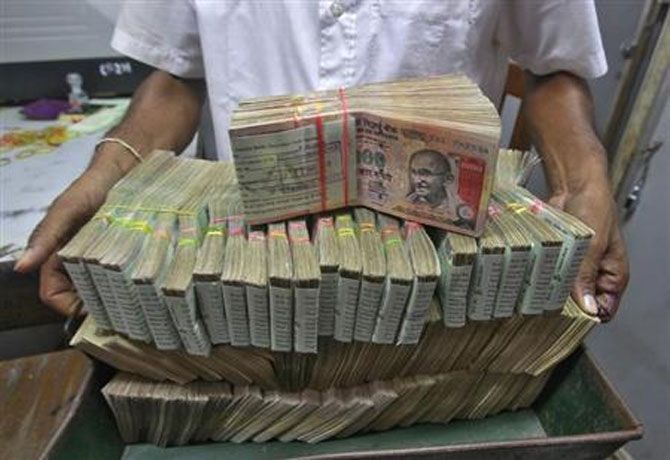Reserve Bank of India's asset quality review of large lenders shows under-reporting.
 Reserve Bank of India (RBI) Governor Raghuram Rajan’s insistence on a “deep surgery” to help banks regain health has uncovered that nearly half of the lenders’ stressed assets were not reported.
Reserve Bank of India (RBI) Governor Raghuram Rajan’s insistence on a “deep surgery” to help banks regain health has uncovered that nearly half of the lenders’ stressed assets were not reported.
RBI had made banks go through an asset quality review (AQR) to clean up their balance sheets. Rajan had linked the AQR programme to a “deep surgery” needed for banks to regain health.
The review has showed that public sector banks were not alone in under-reporting bad assets. Large private banks were also doing so.
Out of the total slippages in Axis Bank and ICICI Bank in the third quarter (Q3) of 2015-16, 50 per cent and 66 per cent, respectively, were on account of the AQR exercise.
In the fourth quarter (Q4), AQR accounted for 43 per cent of ICICI Bank’s slippages.
Notably, Axis had accounted all AQR loans in Q3 itself. ICICI Bank, on the other hand, provided for Rs 3,000 crore towards AQR slippages in Q4. HDFC Bank, Kotak Mahindra Bank and IndusInd Bank had nothing to account for under AQR, making these exceptions in the Indian banking industry.
Of the total slippages of large banks that have reported their results so far, about 44 per cent were because of the AQR in the second half of FY16.
The country’s largest lender, State Bank of India (SBI), is yet to declare its Q4 results.
But in Q3, the bank shocked everyone by declaring 71 per cent slippages towards AQR.
For the rest of the public sector banks, AQR accounted for between 25 and 47 per cent of the total slippages in Q4.
But this is not the end of the problem. The banks have time till March 2017 to clean up their balance sheets.
Analysts have said smaller banks were still treating some of the accounts as standard, though their larger peers have shown these as bad debts.
Such accounts would inevitably have to be recognised as bad debts in the coming quarters. “On a system basis, if we were to aggregate, the total AQR number is lower than 50 per cent. The bigger problem has come from non-AQR portfolio,” said Suresh Ganapathy, financial analyst at Macquarie Capital.
Additionally, the worry was that even after providing for AQR loans, most private and public banks have disclosed hefty “watch lists” of loans that they fear could turn bad.
For instance, ICICI Bank's watch list stood at Rs 44,000 crore, while that of Axis was Rs 22,600 crore.
Among public sector banks, Bank of Baroda topped the list at Rs 15,000 crore, followed by Punjab National Bank and Bank of India at Rs 11,000 crore each.
What these banks are going to do about these bad loans is not clear.
Bank of India Managing Director and CEO Melwyn Rego said his bank had a recovery and upgrade target of Rs 17,000 crore in the current financial year.
The bank would try to recover more than what it had incurred in slippages.
If not, recovery and upgrade should match slippages, Rego said. Other banks also had similar responses.
However, analysts have called these targets as “too ambitious” and were skeptical of the lenders meeting these.
This was because the targeted levels indicated a multi-fold increase in recoveries over FY16.
“Those loans are bad for a reason and it is not that banks have managed to stop slippages,” said an analyst with a brokerage who did not wish to be named. “When they are not able to protect their standard loans, it would be too ambitious to think of them recovering their old bad loans.”
Bankers have acknowledged that they have not yet managed to close the lid on bad loans.
“I cannot say the worst is over,” Usha Ananthasubramanian, managing director and chief executive officer of PNB, had said at the bank’s results conference.
“The stress will continue for some more time. Till the economy doesn’t revive and stressed sectors improve, pressure on bank’s balance sheets will continue.”
Bank of India’s Rego was “cautiously optimistic”. “The bank expects to face asset quality pressure but the magnitude would be far less than what we witnessed,” Rego had said at the bank’s results conference.
Union Bank chairman and managing director Arun Tiwari said the situation was improving but he did not commit a time frame for a complete recovery. “I can only say that March 2017 results will be better in all quality parameters than this quarter.”
While a pick-up in economic growth and private capex would lead to lower asset quality stress for banks, such a situation would take time.
Till then, investors would be better off staying away from PSU banks, analysts added.









